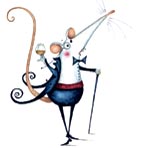Town mouse on the joys of Dickens
Clive is reminded of the joys of his favourite Dickens novel, Our Mutual Friend


Most of last week was spent in the car so much so that I succeeded in listening to all 28 CDs of David Timson's superb reading of Our Mutual Friend. It's my favourite Dickens novel.
Nearly all the story takes place in London. It's not the London of Oliver Twist's ‘rookeries', but the waterside London of Limehouse Hole and the crazily anthropomorphic Six Jolly Fellowship Porters pub; the London of the Wilfers' Pooterish residence at Holloway, where the first floor is vacated for a mysterious lodger; the London of dismally pompous houses near Cavendish Square, of harmless Twemlow living in as much gentility as he could afford over a stables in St James's, of giant dust mounds north of what is now King's Cross, of the streets around Smith Square, where Thomas Archer's ‘very hideous church with four towers at the corners' is described as ‘resembling some petrified monster, frightful and gigantic, on its back with its legs in the air'.
Through the whole novel flows the Thames, like life itself, indifferently carrying all manner of cargo out to the open sea. It's a fairy story, in which the heroines, however lowly born, speak grammatically and the worst of the villains die in the river, of course. A fairy story, but, just as Dickens intended, I wept: very inconvenient when driving.
Sign up for the Country Life Newsletter
Exquisite houses, the beauty of Nature, and how to get the most from your life, straight to your inbox.
Country Life is unlike any other magazine: the only glossy weekly on the newsstand and the only magazine that has been guest-edited by HRH The King not once, but twice. It is a celebration of modern rural life and all its diverse joys and pleasures — that was first published in Queen Victoria's Diamond Jubilee year. Our eclectic mixture of witty and informative content — from the most up-to-date property news and commentary and a coveted glimpse inside some of the UK's best houses and gardens, to gardening, the arts and interior design, written by experts in their field — still cannot be found in print or online, anywhere else.
-
 Vertigo at Victoria Falls, a sunset surrounded by lions and swimming in the Nile: A journey from Cape Town to Cairo
Vertigo at Victoria Falls, a sunset surrounded by lions and swimming in the Nile: A journey from Cape Town to CairoWhy do we travel and who inspires us to do so? Chris Wallace went in search of answers on his own epic journey the length of Africa.
By Christopher Wallace
-
 A gorgeous Scottish cottage with contemporary interiors on the bonny banks of the River Tay
A gorgeous Scottish cottage with contemporary interiors on the bonny banks of the River TayCarnliath on the edge of Strathtay is a delightful family home set in sensational scenery.
By James Fisher